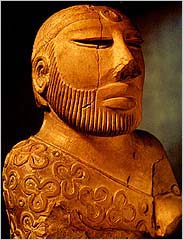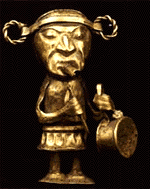 Statue of a priest or ruler from Mohenjodaro, a city of the Harappan Culture in the Indus Valley |
ANT 350
Ancient
Civilizations: the roots of diversity
This semester we'll be looking at the rise of the great civilizations of the ancient world. We'll start by looking at the roots of three ancient civilizations surrounding the Arabian Peninsula: the Sumerians of Mesopotamia, the Egyptians and Nubians in the Nile Valley, and the Harappans in the Indus Valley.
We'll then move on to examine ancient China from the Xia dynasty through China's unification under Qin Shihuangdi.
We'll then shift our focus to Central Americawhere will look at the rise of the Maya, Teotihuacan, and the Aztec civilizations. We'll finish the course by examining the indigenous civilizations of Peru, Bolivia, Argentina, and Chile from the Moche through the Incas.
Workload
 Gold statue of a Chimu musician |
The required assignments will send students to English language web sites. Students who are comfortable with Arabic, Chinese, or Spanish will be encouraged to make optional visits to web sites in those languages.
You can expect several quizzes and assigned essays.
Textbook
The readings for this course come from several textbooks. The assigned readings will be available on-line.
Optional: If you would like to have a single reference textbook, you should get a copy of Brian Fagan's People of the Earth. Any edition will do. I will not be using this textbook, but many students have asked for a reference textbook. This book can be very expensive if you purchase the most recent edition..
What's
a web-course like?
If you've never taken a web course, please look at frequently
asked questions
If you decide to take the course, be sure to visit Things to To Before You Start the Course